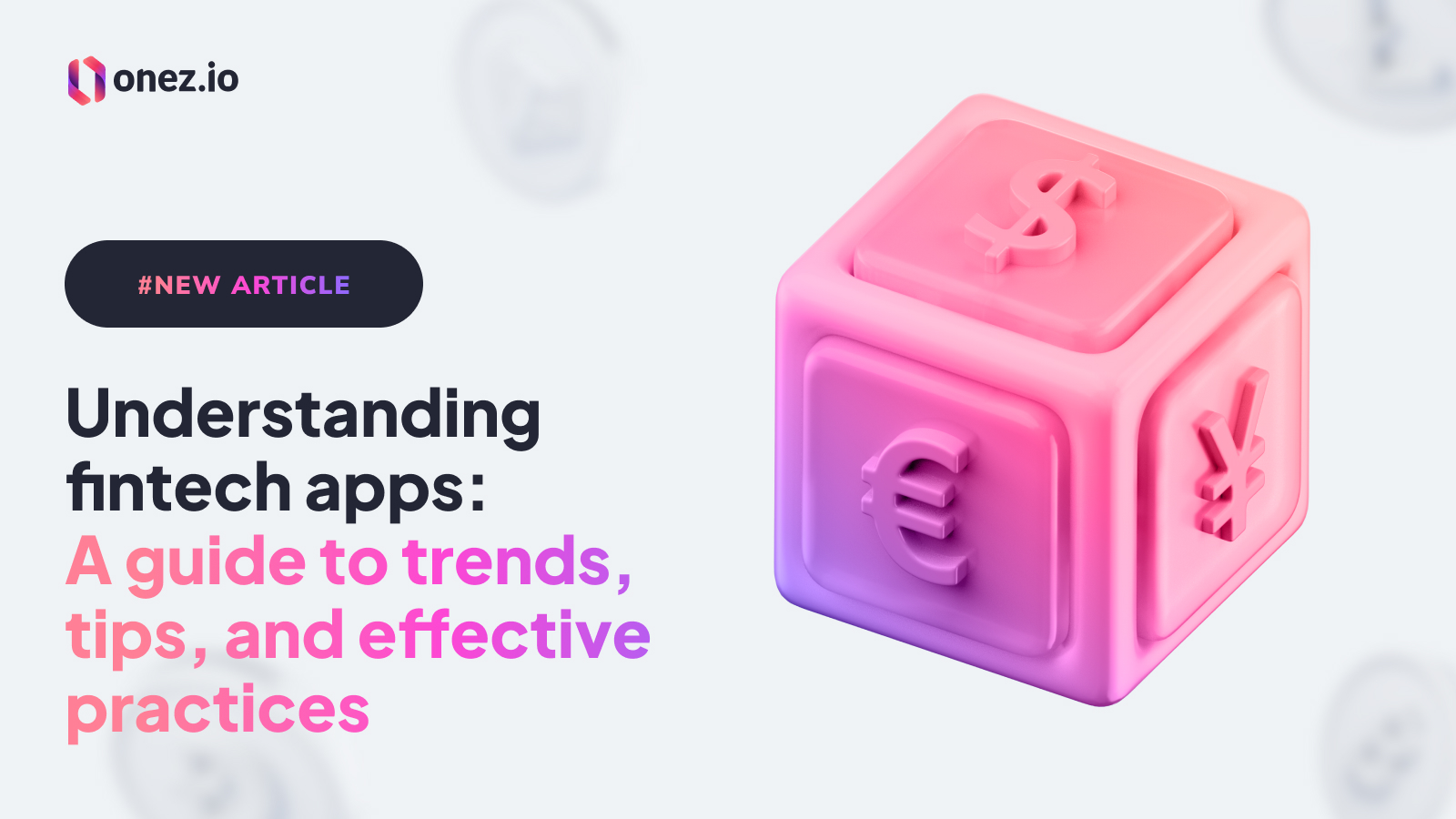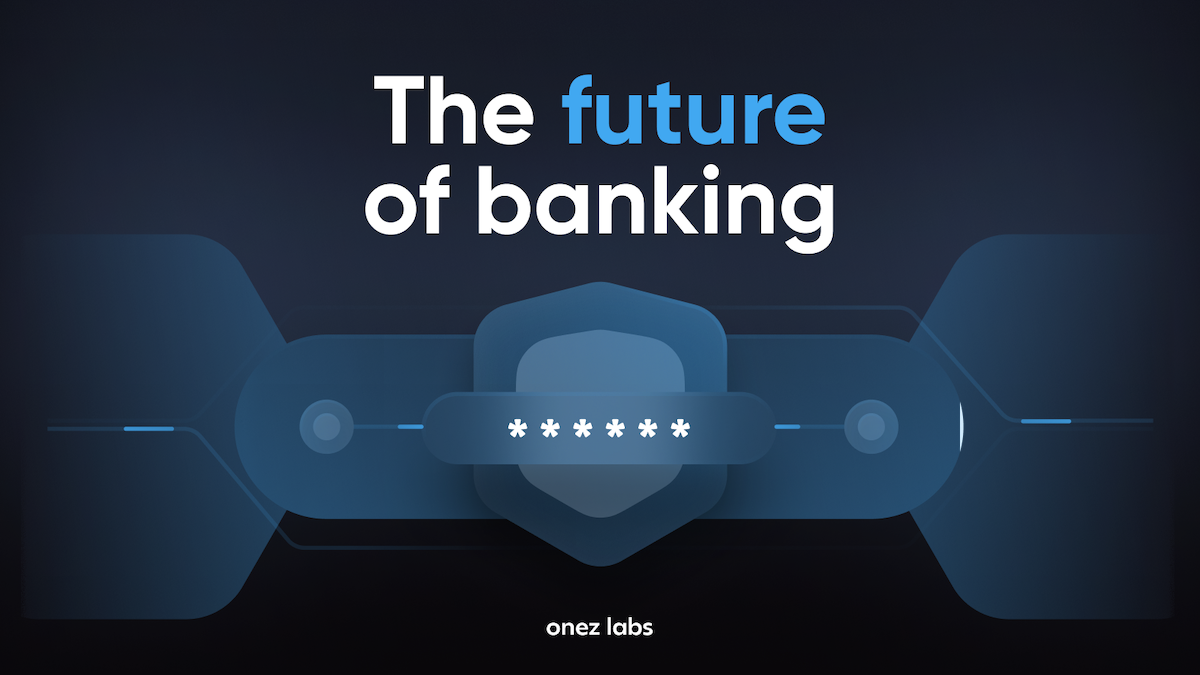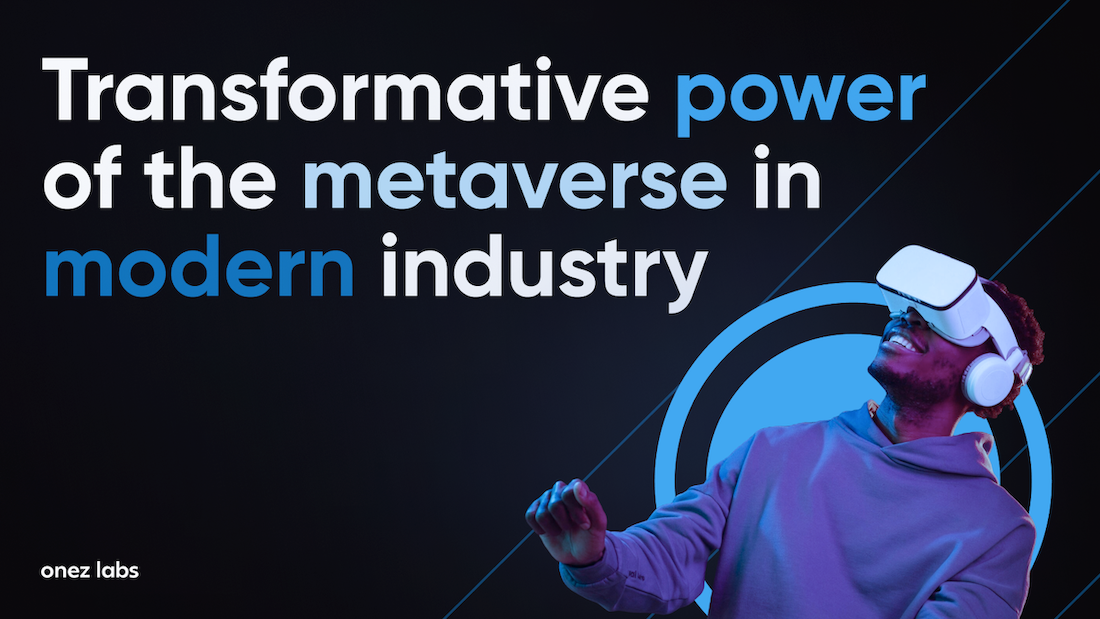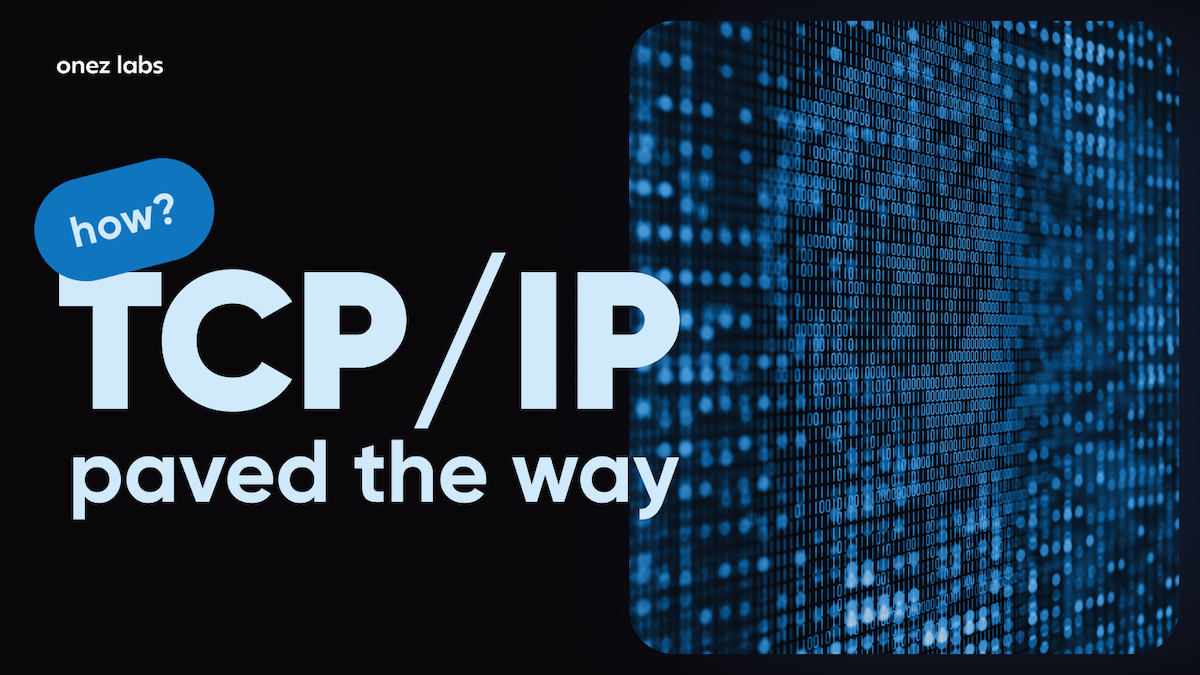Table of Contents
- Overview of the fintech app market
- What is a fintech App?
- Types of fintech apps
- Fintech industry market trends
- Steps to build a fintech app
- Ideation phase
- Must-have features of fintech apps
- Importance of security in fintech apps
- Tips for selecting a fintech app development company
- The advantage of choosing Onez as your fintech development partner
- Predictions for fintech app future development
- What to expect in the future of fintech applications.
- Conclusion
- FAQ
Overview of the fintech app market
Fintech apps are becoming really popular because they help people handle their money better. These apps use fancy technology to do things like keeping track of your spending, saving money, investing, and paying your bills. Whether you want to see where your money goes, send cash to pals, or even borrow some dough, there’s probably an app for that. Lots of new apps keep popping up, and the old ones keep getting better to give you more stuff to do with your money. So, you’ve got tons of choices to pick from, letting you manage your money the way you like it.
Fintech apps are super important because they help more people access banking digitally, especially those in underserved communities or regions with limited access to traditional banking services. They make it easy for anyone to handle important financial tasks without having to go to a physical bank.Plus, these apps often provide people with educational resources So they can make smarter choices. By making banking easier and teaching people about finance, fintech apps are creating a big impact in our society today, making a big difference in people’s lives, especially those who might not have had these opportunities before.
What is a fintech App?
The term “fintech app” might sound fancy, but it’s actually quite simple. A fintech app is just an application in your phone that helps you with financial tasks.It’s just like having the whole of banking services right in your pocket, which is your smartphone. These apps use technology, like your phone’s internet connection, to do things like helping you save money, send money to friends, or even invest your money. So, instead of going to a bank and waiting in line, you can just tap on your phone screen to do what you need to do with your money. It’s quick and easy!
Fintech apps come in all shapes and sizes, each one is designed to help you with different aspects of your finances.Some help you track spending and stick to a budget, while others make it easy to send money to friends. Then there are ones that help you invest your cash, giving advice or letting you buy stocks on your phone. No matter what you need, there’s likely a fintech app that can help you out!
Types of fintech apps
There are 8 types of fintech applications, which includes payment apps, banking apps, investment apps, lending apps, insurance apps, financial management apps, blockchain and cryptocurrency apps, and Regtech apps.
Now let’s find out how each of them operates.
| Apps types | Examples of such apps are |
|---|---|
| Payment apps: These apps allow users to send and receive money easily, pay bills, and make purchases online or in-store using their smartphones | PayPal, ApplePay, Google Pay, Cash App |
| Banking apps: Users can manage their bank accounts, check balances, view transaction history, transfer money between accounts, and deposit checks using these apps | Ally bank, Bank of America, CapitalOne, Chase Bank |
| Investment apps: These apps allow users to invest in stocks, bonds, mutual funds, and other investment products, as well as track their investment portfolio and receive market updates | Acorns, Fidelity, Robinhood, Betterment |
| Lending apps: Users can borrow money, apply for loans, and manage loan repayments through these apps, which often offer quick approval processes and flexible repayment options | LendingClub, SoFi, Prosper, Kiva |
| Insurance apps: Users can purchase insurance policies, file claims, track claims status, and manage their insurance coverage using these apps, which gives convenience and accessibility for policyholders | The General Auto Insurance App, Root, Jerry, myLife |
| Financial management apps: These apps help users track their expenses, create budgets, set financial goals, and monitor their overall financial health, often offering personalized insights and recommendations | Goodbudget, YNAB, PocketGuard, Money Manager Classic Lite |
| Blockchain and cryptocurrency apps: Users can buy, sell, and trade cryptocurrencies like Bitcoin and Ripple, as well as manage their digital wallets and track cryptocurrency prices and market trends | Coinbase, Kraken, Binance, Gemini |
| Regtech apps: These apps assist financial institutions with regulatory compliance by automating compliance processes, monitoring regulatory changes, and making sure adherence to industry regulations and standards. | ComplyAdvantage, OneTrust, Fenergo, NICE Actimize |
Fintech apps do lots of things to help with finance. Some keep track of spending and help you save, while others let you send money fast and safely. Then, there are apps for investing, where you can buy stocks and keep an eye on how your money’s doing. They all help you manage money better and reach your financial goals.
Past July 2023, the combined value of fintech companies that are traded on the stock market reached $550 billion. This is twice as much as their value in 2019. This data is based on the F-Prime Fintech Index.
Fintech industry market trends
In the fintech industry trend, things are not usually the same, change’s and cool features are being introduced everyday. Developers keep inventing new ways to make handling money easier for everyone. One big thing happening now is that these apps are getting smarter. They’re utilizing tech like artificial intelligence to learn about you and how you use money. This helps them give you better advice, like finding ways to save on things you buy a lot. Another cool thing is that they’re getting more personal. They’re customizing their features to fit what you need and want. It’s like having your own personal financial advisor right on your phone! The credit should go directly to the US cause they’re the largest fintech country in the world?
According to the source across the web, the report states that the United States hosts 134 unicorns, making it the leading producer of value in the fintech industry, out of the top 15 valuable fintech companies worldwide, eight are from the US.
With India ranking third among the countries with the most financial technology (fintech) they host about 108 unicorns. with a total valuation of $340.80B as of 2023.
| Rankings | Name | Type of company |
|---|---|---|
| 1 | Visa | Paytech |
| 2 | Mastercard | Paytech |
| 3 | Intuit | Accounting |
| 4 | Shopify | Ecommerce |
Fintech apps have been providing us with so much Excitement and satisfaction. Another trend is digital wallets. They can store all your payment cards on your phone, making it easy to pay without carrying plenty of cards.peer-to-peer lending apps are Also a new trend now.They can connect people who need to borrow with those who want to lend, making borrowing easy and safe. Lastly, robo-advisors are Also making Waves. These apps automatically manage your investments, removing the stress out of investing and helping you grow your money effortlessly.
with some cool new trends popping up. Number one purpose of Fintech applications is making sure everyone has access to financial services. Apps are reaching out to communities that don’t usually have access to banking services, giving services tailored to their specific needs. They’re also making everything more simple, like making it easy to open an account or using languages that more people understand. Another thing is using blockchain technology in fintech apps. It’s super secure and transparent, which helps with stuff like verifying identities and making payments across borders. And also, more apps are letting people invest in things that’s good for the planet and society, so you can put your money where your values are.
According to Cryptorank data, the total value locked (TVL) of the General Blockchain exceeded $100B in the past 6 months.This shows how rapidly the fintech industry is adopting and growing to offer us a better future that everyone will enjoy.
Steps to build a fintech app
- Ideation Phase
- Planning and Design
- Development Process
- Testing and Quality Assurance
- Launch and Post-Launch Strategies
Ideation phase
So, you’ve got an idea for a fintech app, but you’re not sure where to start? Don’t worry, building a fintech app is a step-by-step process that begins with the ideation phase. This is where you brainstorm ideas for your app and think about what features and services you want to offer. You’ll also need to research the market and see what other fintech apps are out there. Once you have a clear vision for your app, it’s time to move on to the planning and design phase.
Planning and design
In the planning and design phase, you’ll create a roadmap for your app and decide how it will look and function. You’ll work closely with fintech app developers to design wireframes and mockups that outline the layout and user interface of your app. This is also when you’ll start thinking about the technology stack you’ll need to build your app and whether you’ll hire a fintech app development company or build your own team of developers.
Development process
Once you’ve finalized the design of your app, it’s time to move on to the development process. This is where the magic happens, as your team of fintech app developers brings your vision to life. They’ll write the code, build the features, and link any third-party services or APIs you need. Throughout the development process, it’s important to stay in close communication with your team and provide feedback on their progress. Meanwhile, there are platforms that help individuals with building fintech applications. An example is ONEZ. These are for those who need a quick launch and want to offer services without coding the app from scratch. We’ll still come to that. For now, let’s continue with the testing phase.
Testing and quality assurance
After your app has been developed, it’s time to move on to testing and quality assurance. This is where you’ll make sure that your app works as intended and is free of any bugs or glitches. You’ll conduct thorough testing on different devices and operating systems to ensure compatibility and usability. Once your app passes all the tests, you can move on to the next step: launch.
Launch and post-launch strategies
Launching your fintech app is an exciting moment, but it’s important to have a solid post-launch strategy in place to ensure its success. This might include marketing and advertising campaigns to promote your app, as well as ongoing updates and improvements based on user feedback. You’ll also need to think about how you’ll monetize your app, whether through subscription fees, in-app purchases, or advertising revenue.
building a fintech app is a complex but rewarding process that requires careful planning, design, development, testing, and launch strategies. By following these steps and working closely with a team of experienced fintech app developers like ONEZ.IO, you can bring your vision for a fintech app to life and make a positive impact in the society.
Must-have features of fintech apps
When making a fintech app, some important features are needed for it to work well. These include basic things like creating an account, logging in safely, and managing personal info. Users should also be able to do common financial tasks like checking balances, sending money between accounts, and paying bills. Security is super important too, to keep users’ info and transactions safe. This could mean using security like two-factor authentication, encrypting data, and updating security regularly to stop anyone from getting in without permission.
Having a user-friendly interface and experience is very important for fintech apps. This will make the app easy to use and understand, mostly for people who aren’t super tech-savvy. Using clear language to explain features and instructions, and making buttons and icons big enough to tap easily on a touchscreen, Also, giving helpful hints and guidance as users go along can make the app even more enjoyable to use.
Integration with financial services
Integration with financial services is an essential feature of fintech apps. This means connecting the app to external financial institutions and services to make transactions and sharing data smooth. For instance, users should link their bank accounts, credit cards, and investment accounts to get a complete picture of their finances. It’s also important to integrate with payment gateways for easy transactions within the app, like sending money or buying stocks. By connecting with different financial services, fintech apps give users a complete and convenient way to manage their money.
Importance of security in fintech apps
Security is super important for fintech apps. Since these apps deal with sensitive financial information, it’s important to keep user info safe. Developers work hard to build strong security features into the apps. They use strong encryption to keep data safe as it moves between the app and the user’s device. This makes it really tough for hackers to get in. Also, many fintech apps use extra security measures like making users provide more than one way to prove they’re who they say they are before they can access their accounts. This extra layer of security helps keep out the bad guys.
To keep fintech apps safe, developers do a few important things. First, they regularly update the app with the latest security fixes to stay ahead of hackers. They also check the app thoroughly for any weak spots by doing security tests, kind of like practicing cyber attacks. If they find any problems, they fix them right away. Plus, they make sure only the right people can get into the app by using strong access controls. By doing all this, developers make sure fintech apps are really safe and keep users’ info protected.
Tips for selecting a fintech app development company
Choosing the right team to develop your fintech app is very important for its success. Here are some tips to help you make the best choice. First, look for a company that has experience specifically in fintech app development. They need to understand financial rules, security stuff, and what users want. Second, check out their past work to see if they’ve done good stuff before. Look at other fintech apps they’ve made and see if they match what you want for your app.
Picking the right team for your fintech app is a big deal. Consider stuff like their experience, how they’ve done before, how well they talk, their reputation, and if they can handle your app growing. Take your time and research your options to find the best fit. With the right team, you can make a fintech app that’s awesome for your users and helps your business succeed.
The advantage of choosing Onez as your fintech development partner
Choosing us comes with a ton of perks for startups going into the Fintech/Web3 industry. At Onez, we’re focused on making blockchain technology less intimidating so entrepreneurs can start and launch their blockchain product with full confidence. The service we offer at Onez.io gives fintech, mostly startups, access to top-notch blockchain solutions customized to their needs. We set them up for success in the decentralized web industry. We empower entrepreneurs by offering ready-to-go blockchain platforms that can be rebranded for the intended purpose and immediately start offering services, no need for a ton of technical know-how. This user-friendly approach we offer at Onez.io not only makes things easier but also helps startups get a solid footing and establish a successful Blockchain business, even if they’re not coding pros.
But wait, Onez.io isn’t just about making exaggerations; we’re focused on creating a whole new system for the future. We believe in working together and coming up with new ideas. Security is really important in the world of blockchain, and with Onez.io, startups can be sure that their websites are really safe, keeping their information and money protected. We’ve helped lots of startups succeed in the Web3 industry, and people love what we do. If you want to launch any blockchain technology without any worries, Onez.io is the best choice if you love qualities.
Predictions for fintech app future development
Looking to the future of fintech app development, exciting changes are coming. With more of Artificial Intelligence (AI) and Machine Learning (ML) in fintech apps. These technologies can make big improvements by learning from users to give personalized tips and insights. For instance, they might suggest ways to save money based on spending habits. Also, AI chatbots can give instant help, making users happier and also encouraging engagement.
Alongside AI and ML, other cool technology that is promising for the future of fintech apps. One of them is decentralized finance (DeFi) on blockchain. These apps offer individuals financial services without banks, giving users more control over their data.Then,there’s also a biometric authentication like fingerprint scanning or facial recognition, making everything safer and easier for users when they log in or do transactions.
Predictions said Fintech Total valuation is expected to reach $882.30 billion by 2030, exhibiting a CAGR of 17.0% over the study period.
What to expect in the future of fintech applications.
The future of fintech apps looks bright! and promising.With more AI, ML, blockchain, and biometric stuff, they’ll be even better at managing money. They will also make Everything easier to use and open up more opportunities for everyone to manage their finances. As developers keep pushing boundaries, fintech apps will keep getting better to meet the needs of the masses in the future.
Conclusion
Throughout our discussion, we’ve stressed how fintech apps make managing money easier for everyone. We’ve talked about important things like keeping apps secure, easy to use, and able to connect with financial services well. It’s important for developers to follow good practices to make sure their apps work well.
Looking forward, these exciting things happening in fintech app development. That includes using AI and ML, improving blockchain tech, and using biometrics like fingerprints for security. These changes will make apps better for users and help more people access financial services more securely.
No doubt they’re a big deal in today’s finance industry, offering handy ways to handle money and use financial services. By keeping up with what’s happening in the industry and using new technology, developers and users can help fintech apps keep getting better. We encourage everyone to stay interested in fintech, keep up with the news, and see how fintech apps can help the masses reach their financial goals. Together, we can build the future of finance and make finance easier for everyone to access effortlessly.
FAQ
What is fintech in simple terms?
Fintech, short for financial technology, refers to the use of technology to improve and innovate financial services. It includes different types of applications such as mobile banking, online payment platforms, robo-advisors for investments, and blockchain-based cryptocurrencies. Basically, fintech aims to make financial services more efficient, accessible, and convenient for individuals and businesses.
Is PayPal a fintech?
Of course, PayPal is considered a fintech company. It provides online payment solutions that allow individuals and businesses to send and receive money electronically. Also, PayPal offers other financial services such as peer-to-peer payments, online invoicing, and payment processing for merchants.
Will fintech replace banks?
As of now, fintech may challenge traditional banks, but it’s unlikely to replace them entirely. Instead, they’re likely to coexist, with banks adapting to incorporate fintech innovations to stay competitive. Meanwhile, we aren’t sure of what would happen in the future, but rest assured fintech is here to stay.
What jobs are in fintech?
There are several jobs in fintech, including roles like blockchain expert/developer, app developer, product owner/manager, financial analyst, and cybersecurity expert/analyst. Working in fintech brings different and exciting career paths at the forefront of technological innovation in finance.
Who uses fintech?
Fintech is used by individuals, businesses, banks, and governments. People use fintech for banking, investing, and payments. Businesses use it for finance, payments, and loans. Banks use it to improve services and reach more customers. Governments use it for regulations and financial inclusion. Overall, fintech helps everyone access financial services easily.



